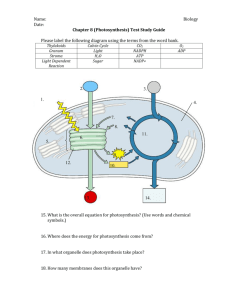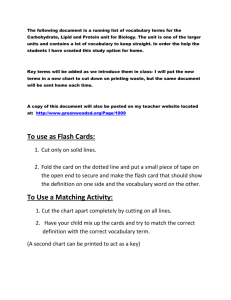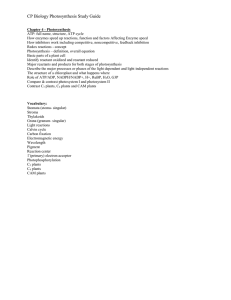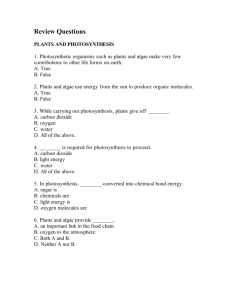PowerPoint
advertisement
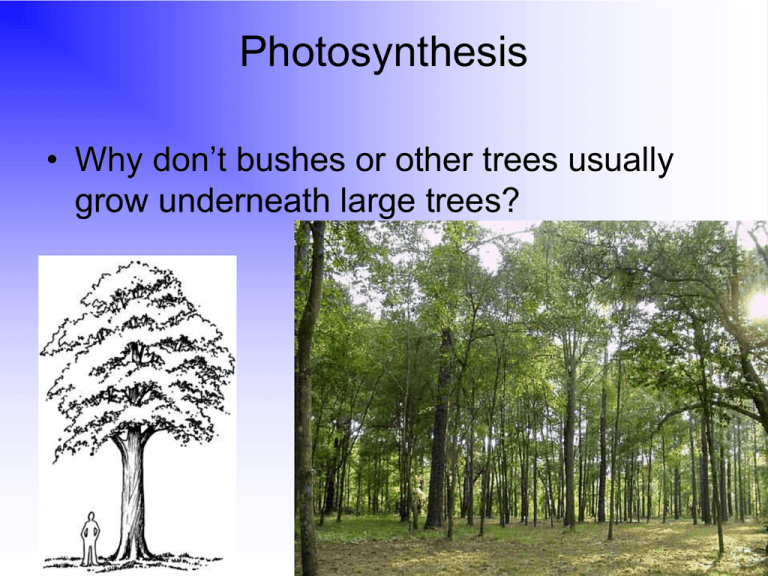
Photosynthesis • Why don’t bushes or other trees usually grow underneath large trees? Lesson Objectives • Identify the kind of energy that powers life. • State why living things need energy. • Evaluate the importance of autotrophs for providing energy to all life. • Describe how autotrophs and heterotrophs obtain energy. • Define chemosynthesis. • Compare and contrast glucose and ATP. • Outline how living things make and use food. • Outline the stages of photosynthesis. • Describe the chloroplast and its role in photosynthesis. • Identify the steps of the light reactions and the Calvin cycle. Terminology Review • What is energy? The ability to do work. _________________________________ • What is the ultimate source of all energy? Sunlight _________________________________ Kinds of energy which power life • What forms can energy come in? Light, heat, chemical, nuclear, magnetic, and electrical __________________________________ • Where is energy stored? In chemical bonds __________________________________ • How is this energy released? By breaking the chemical bonds __________________________________ How Do Organisms Get Energy? Autotrophs vs. Heterotrophs Living organisms obtain chemical energy in one of two ways. They make it themselves OR They consume those who can make it themselves CAN MAKE IT THEMSELVES Autotrophs—Photosynthesize • Plants, algae, and some bacteria • Producers, begin food chains which feed all life – Store chemical energy in carbohydrate food molecules • Organic molecules made through photosynthesis store chemical energy (food) Photosynthesis • Provides over 99 percent of the energy supply for life on earth – Uses solar energy to convert water and carbon dioxide into oxygen and glucose CONSUMERSHeterotrophs • Animals, fungi, and many protists and bacteria • Consumers, cannot make their own food – Obtain energy through food consumption • Autrotrophs or other Heterotrophs – Highly diverse organisms Chemosynthesis • Other autotrophs: mostly bacteria in dark or low-oxygen environments – produce food using the chemical energy stored in inorganic molecules such as hydrogen sulfide, ammonia, or methane. Tubeworms deep in the Gulf of Mexico get their energy from chemosynthetic bacteria living within their tissues. No digestive systems needed! Food to Energy Molecules: Glucose and ATP • Two of the most important energy-carrying molecules • Glucose: simple carbohydrate; energy-rich product of photosynthesis; chemical formula C6H12O6 – “deliverable” form of energy; carried in blood through capillaries and taken up by trillions of cells – nearly universal food for life. • ATP: store smaller quantities of energy; product of first stage of photosynthesis and used during second stage to make glucose – provides cells with energy for cellular processes – “useable” form of energy for your cells Why Organisms Need Both Glucose and ATP • Glucose more chemical energy in a smaller ‘‘package” than a molecule of ATP – more stable than ATP; better for storing and transporting energy – BUT too powerful for cells to use. • ATP right amount of energy to power life processes within cells – like a rechargeable battery • energy released when broken down into ADP and phosphate • “worn-out battery” ADP recharged using new energy to attach a new phosphate; rebuilds ATP. ATP and ADP • ATP: adenosine triphosphate; principle chemical compound in which living things store energy. Adenine: nitrogen-containing compound Ribose: a 5-carbon sugar 3 phosphate groups • ADP: adenine diphosphate; structural similar to ATP but with one important difference: ADP has only two phosphate groups. ADP is converted to ATP when available energy is used to add a phosphate group to it. ADP two phosphates Adenine: nitrogen-containing compound Ribose: a 5-carbon sugar 2 phosphate groups Releasing Energy from ATP • Energy stored in ATP is released when it is converted to ADP and a phosphate group. Adding or subtracting a 3rd phosphate group allows the cell to store and release energy as it is needed O Using Biochemical Energy • How the cells use ATP: – To conduct active transport; like the sodiumpotassium pump • It moves sodium ions (Na+) out of the cell and potassium ions (K+) into the cell • A single ATP molecule provides the energy to move three sodium ions and two potassium ions in different directions – Powers movement within the cell • Moves cell organelles along microtubules by motor proteins that use energy from ATP to generate force http://student.ccbcmd.edu/~gkaiser/biotutuorials/eustruct/sppump.html Photosynthesis: The Most Important Chemical Reaction for Life on Earth • Necessary conditions include: – enzymes - proteins to speed up chemical reactions – chlorophyll - a pigment which absorbs light – chloroplasts – which contain chlorophyll, accessory pigments, and enzymes in patterns which maximize photosynthesis Stages of Photosynthesis • Two stages: – light reactions uses water; changes light energy into chemical energy • releases oxygen as a waste product. – Calvin cycle uses chemical energy in ATP and NADPH to make glucose Chloroplasts: Theaters for Photosynthesis • Chloroplast contain: – neat stacks called grana (singular, granum). • consist of sac-like membranes, known as thylakoid membranes – Thylakoid membranes • contain photosystems – groups of molecules that include chlorophyll • light reactions occur in thylakoid membranes. – stroma • space outside the thylakoid membranes • reactions of the Calvin cycle occur here Chloroplasts Function • Work with enzymes and two basic molecules: pigments and electron carriers • Electron carrier molecules are usually arranged in electron transport chains (ETCs). Photosynthesis Stage I: The Light Reactions Chloroplasts Capture Sunlight’s Energy Light-Dependent Reactions • Require LIGHT • Use light energy to produce – Oxygen gas – Convert ADP to energy carrying ATP – Convert NADP+ to energy carrying NADPH Photosynthesis Stage II: The Calvin Cycle Making Food “From Thin Air” • Three major steps: – Carbon fixation – Reduction – Regeneration http://www.science.smith.edu/departments/Biology/Bio231/calvin.html Why is Carbon Dioxide “Fixed” • Life on Earth is carbon-based – needed in building blocks of biological molecules – ultimate source of carbon is carbon dioxide • Animals and most other heterotrophs cannot take in CO2 directly • Only autotrophs can build low energy inorganic CO2 into high-energy organic molecules like glucose Three Pathways for Carbon Fixation—Calvin Cycle 1. C-3 pathway a. Most common b. 6-C molecule splits into two 3-C molecules Dry air, hot temperatures, bright sunlight lead to below two pathways: 2. C-4 pathway a. creates a 4-C molecule 3. CAM (Crassulacean Acid Metabolism) a. cacti and succulents b. Fix carbon dioxide at night Factors Affecting Photosynthesis • Shortages of water slow process down; can stop it – Plants that live in dry areas have a waxy coating on their leaves that reduces water loss • Temperature also can slow or stop it – Enzymes used by plants for photosynthesis function best between 0°C and 35°C (32°F to 95°F) • Intensity of light – More light = greater rate of photosynthesis until maximum reached • Maximum rate varies from plant to plant Let’s Review • Where does photosynthesis occur? In the chloroplasts _________________ • What are the saclike photosynthetic membranes thylakoids in the chloroplast called? _________________ • The thylakoids are arranged in stacks called grana __________. • What is found inside the grana? Clusters of chlorophyll and other pigments ______________________________________ • What are photosystems? Proteins found in the grana ______________________________________ • What do photosystems do? They capture the energy of sunlight ______________________________________ • How many stages does photosynthesis 2 have? ______ • What are they? Light reactions __________________________________ Light-independent reactions (Calvin cycle) __________________________________ • Where do the light-dependent reactions take place? Thylakoid membrane __________________________________ • Where do the light-independent reactions take place? Stroma; region outside of the thylakoid membrane __________________________________



